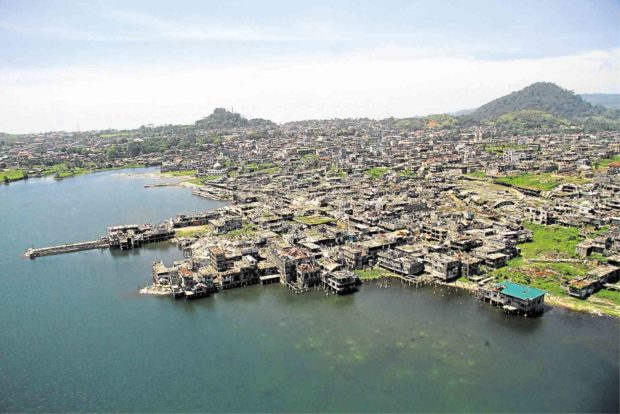
VIEW OF DESTRUCTION Aerial view of ground zero, or the area that became a battlefield between soldiers and Islamic State, in Marawi City. —RICHEL V. UMEL
ZAMBOANGA CITY—Incoming Armed Forces Chief Lt. Gen. Carlito Galvez expressed objection to allowing residents of Marawi to return to their homes, saying all structures in ground zero of the war on Islamic State (IS) in the city had suffered serious damage that made these unsafe.
Galvez, newly appointed by President Duterte as Armed Forces of the Philippines chief, said even the residents’ visits to their homes, called Kambisita, should not have been allowed.
Kambisita allowed residents to visit, but not stay in, their homes or whatever was left of these.
The program started on April 1 and would end on May 10. Hundreds of residents took advantage of Kambisita to salvage belongings and valuables from their houses.
‘Hazardous structures’
Galvez said his objection to letting residents return was anchored on his concern about their safety.
“All the buildings there are structurally hazardous,” Galvez said. “It should be uprooted. It should be flattened,” he said.
Drainage systems also needed to be cleared of debris from the war because these had become breeding grounds of mosquitoes, Galvez said.
“It’s paramount for the government to consider first the safety, health and welfare of the people,” he said.
‘Hard fact’
He admitted, though, that it would be difficult to convince residents to wait for up to three years to live in Marawi again. Authorities had estimated that the rehabilitation program might take up to three years to complete.
At least 24 villages had been at the center of the fighting between government troops and local followers of IS led by Maute and Abu Sayyaf members.
“We really empathize with their feelings but the hard fact, really, is they cannot go back,” Galvez said of the residents.
Drieza Abato Lininding, chair of the nongovernment Moro Consensus Group, said Galvez’s statements sent mixed signals to the people of Marawi.
DIPLOMATS IN MARAWI The ambassadors of Singapore, Sri Lanka, Russia, India, Vietnam, Pakistan, Laos and Thailand’s chief of mission pose with top military officials, led by Lt. Gen. Rolando Joselito Bautista, Philippine Army chief, at the site of a housing project for Marawi residents in the village of Mipaga in Marawi. The housing project, which features a 500-square-meter vegetable farm, was built with the help of the Army and Tarlac Heritage Foundation. —CONTRIBUTED PHOTO
Selective safety
He said, while Galvez talked about demolishing all structures damaged by the war, the Task Force Bangon Marawi, which was in charge of the rehabilitation work, had told residents that only government structures would be flattened.
He said ongoing visits of residents to their homes had been incident-free and even provided opportunity to politicians to promote themselves.
“How can it be hazardous for us homeowners but not to public figures?” Lininding said.
He urged Galvez to “clarify his statement because this, again, will draw angst” among residents.
Galvez, who supervised the five-month war on IS in Marawi City, appealed for the people’s patience.
“I know there’s a lot of suffering already but in order to rebuild it, we need patience,” Galvez said.
Lininding said the best way to appease Marawi residents, mostly Maranaos, was for the government to drop its plan to build a military camp in the city.
Old wounds
According to Lininding, the plan would just “reopen old wounds that led us to the centuries-old conflict in Mindanao.”
Galvez, however, said the military would use only a small area for a camp in the city.
“We will expand a little,” he said. “That would be only a small space,” he added.
He said owners of land that would be used for the camp would be compensated. —JULIE ALIPALA

